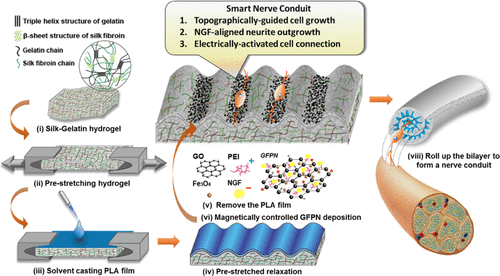当前位置:
X-MOL 学术
›
ACS Biomater. Sci. Eng.
›
论文详情
Our official English website, www.x-mol.net, welcomes your
feedback! (Note: you will need to create a separate account there.)
Spontaneously Micropatterned Silk/Gelatin Scaffolds with Topographical, Biological, and Electrical Stimuli for Neuronal Regulation
ACS Biomaterials Science & Engineering ( IF 5.4 ) Pub Date : 2020-01-15 , DOI: 10.1021/acsbiomaterials.9b01449 Chun-Chang Lin, Jing-Jing Chang, Ming-Chi Yung, Wei-Chen Huang, San-Yuan Chen
ACS Biomaterials Science & Engineering ( IF 5.4 ) Pub Date : 2020-01-15 , DOI: 10.1021/acsbiomaterials.9b01449 Chun-Chang Lin, Jing-Jing Chang, Ming-Chi Yung, Wei-Chen Huang, San-Yuan Chen

|
Effective integration of stimulation and direction in bionic scaffolds by materials and microstructure design has been the focus in the advancement of nerve regeneration. Hydrogels are the most promising biomimicked materials used in developing nerve grafts, but the highly hydrated networks limit the fabrication of hydrogel materials into complex biomedical devices. Herein, facile lithography-free and spontaneously micropatterned techniques were used to fabricate a smart protein hydrogel-based scaffold, which carried topographical, electrical, and chemical induction for neural regulation. The synthesized tissue-mimicked silk-gelatin (SG)/polylactic acid bilayer system can self-form three-dimensional ordered corrugation micropatterns with well-defined dimensions (wavelength, λ) based on the stress-induced topography. Through magnetically and topographically guided deposition of the synthesized nerve growth factor-incorporated Fe3O4–graphene nanoparticles (GFPNs), a biologically and electrically conductive cell passage with one-dimensional directionality was constructed to allow for a controllable constrained geometric effect on neuronal adhesion, differentiation, and neurite orientation. Particularly, the SG with corrugation patterns of λ ≈ 30 μm resulted in the optimal cell adhesion and differentiation in response to the pattern guidance. Furthermore, the additional electrical stimulation applied on GFPN-deposited SG resulted in a 1.5-fold increase in the neurite elongation by day 7, finally leading to the neuronal connection by day 21. Such a hydrogel device with synergistic effects of physical and chemical enhancement on neuronal activity provides an expectable opportunity in the development of next-generation nerve conduits.
中文翻译:

具有地形,生物和电刺激的自发微图案化丝绸/明胶支架,可调节神经元。
通过材料和微观结构设计有效地整合仿生支架中的刺激和方向已成为神经再生的焦点。水凝胶是用于开发神经移植物的最有前途的仿生物材料,但是高度水合的网络限制了将水凝胶材料制造成复杂的生物医学装置的过程。在这里,简便的无光刻技术和自发的微图案化技术被用于制造基于蛋白质水凝胶的智能支架,该支架具有地形,电学和化学诱导的神经调节作用。合成的组织模拟丝明胶(SG)/聚乳酸双层系统可以基于应力诱导的形貌自形成具有明确定义的尺寸(波长,λ)的三维有序波纹微图案。3 Ò 4石墨烯纳米颗粒(GFPNs)是一种具有一维方向性的生物和导电细胞通道,可对神经元粘附,分化和神经突方向进行可控的受约束几何效应。特别是,波纹图案为λ≈30μm的SG响应于图案引导而导致最佳的细胞粘附和分化。此外,在GFPN沉积的SG上施加额外的电刺激,到第7天神经突伸长增加了1.5倍,最终在第21天导致神经元连接。这种水凝胶装置具有物理和化学增强作用神经元活动为下一代神经导管的发展提供了预期的机会。
更新日期:2020-01-15
中文翻译:

具有地形,生物和电刺激的自发微图案化丝绸/明胶支架,可调节神经元。
通过材料和微观结构设计有效地整合仿生支架中的刺激和方向已成为神经再生的焦点。水凝胶是用于开发神经移植物的最有前途的仿生物材料,但是高度水合的网络限制了将水凝胶材料制造成复杂的生物医学装置的过程。在这里,简便的无光刻技术和自发的微图案化技术被用于制造基于蛋白质水凝胶的智能支架,该支架具有地形,电学和化学诱导的神经调节作用。合成的组织模拟丝明胶(SG)/聚乳酸双层系统可以基于应力诱导的形貌自形成具有明确定义的尺寸(波长,λ)的三维有序波纹微图案。3 Ò 4石墨烯纳米颗粒(GFPNs)是一种具有一维方向性的生物和导电细胞通道,可对神经元粘附,分化和神经突方向进行可控的受约束几何效应。特别是,波纹图案为λ≈30μm的SG响应于图案引导而导致最佳的细胞粘附和分化。此外,在GFPN沉积的SG上施加额外的电刺激,到第7天神经突伸长增加了1.5倍,最终在第21天导致神经元连接。这种水凝胶装置具有物理和化学增强作用神经元活动为下一代神经导管的发展提供了预期的机会。











































 京公网安备 11010802027423号
京公网安备 11010802027423号